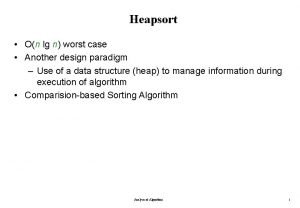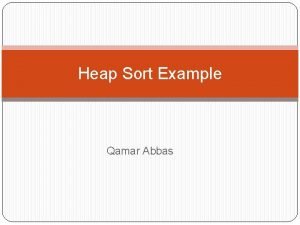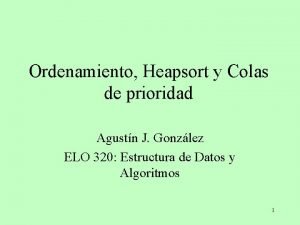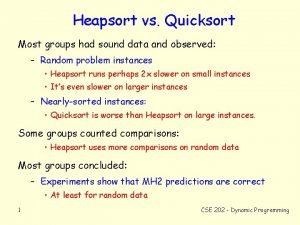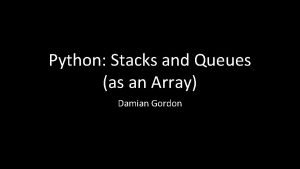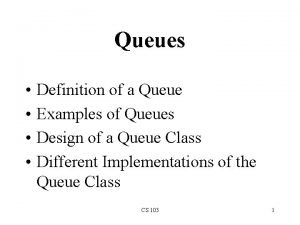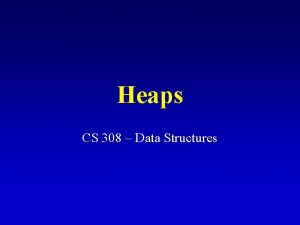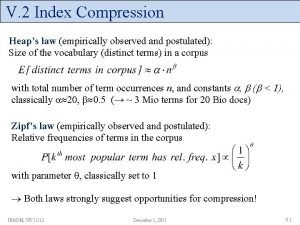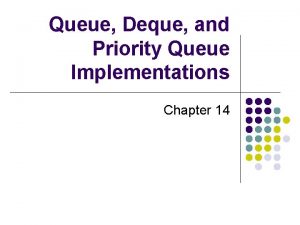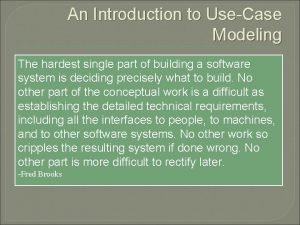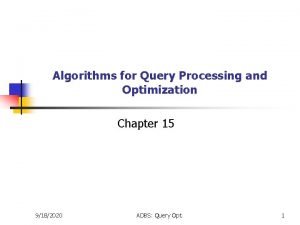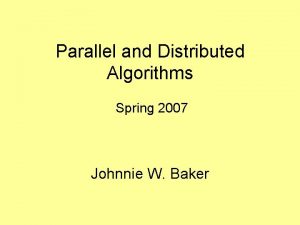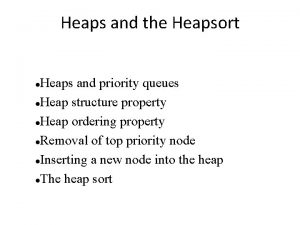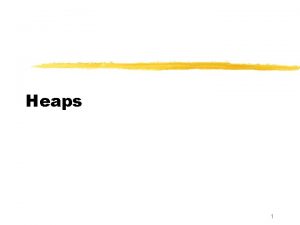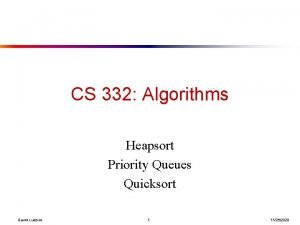Priority Queues Heaps and Heapsort CSE 2320 Algorithms










































![Index Heap Example - Solution HA – Heap to Array (HA[0] has index into Index Heap Example - Solution HA – Heap to Array (HA[0] has index into](https://slidetodoc.com/presentation_image_h2/e5e7759ffdcfe2440241b2c9abd1794d/image-43.jpg)


















- Slides: 61

Priority Queues, Heaps, and Heapsort CSE 2320 – Algorithms and Data Structures Alexandra Stefan (includes slides from Vassilis Athitsos) University of Texas at Arlington 10/24/2021 1

Overview • Priority queue – A data structure that allows inserting and deleting items. – On delete, it removes the item with the HIGHEST priority – Implementations (supporting data structures) • Array (sorted/unsorted) • Linked list (sorted/unsorted) • Heap – (an array with a special “order”) • Heap – Definition, properties, – Operations: • increase key (swim. Up), decrease key (sink. Down), • insert, remove. Max, remove. Any, update – Building a heap: bottom-up (O(N)) and top-down (O(Nlg. N)) • Heapsort – O(Nlg. N) – Not stable • Finding top k: with Max-Heap and with Min-Heap • Extra: Index items – the heap has the index of the element. Heap <-> Data 2

Priority Queues • Goal – to support (efficiently) operations: – Delete/remove the max element. – Insert a new element. – Initialize (organize a given set of items). • Useful for online processing – We do not have all the data at once (the data keeps coming or changing). (So far we have seen sorting methods that work in batch mode: They are given all the items at once, then they sort the items, and finish. ) • Priority. Queue (Java) , priority_queue (C++) • Applications: – Scheduling: • flights take-off and landing, programs executed (CPU), database queries – Waitlists: • patients in a hospital (e. g. the higher the number, the more critical they are) – Graph algorithms (part of MST) – Huffman code tree: repeatedly get the 2 trees with the smallest weight. 3

Priority Queue Implementations index 0 1 2 3 4 5 6 7 8 9 10 11 12 Sorted 1 1 1 2 3 3 3 4 4 5 5 7 9 Unsorted 1 2 7 5 3 5 4 3 1 1 9 3 4 How long will it take to delete MAX? How long will it take to insert value 2? Arrays and linked lists (sorted or unsorted) can be used as priority queues, but they require O(N) for either insert or delete max. Data structure Insert Delete max Create from batch of N Unsorted Array Unsorted Linked List Sorted Array O(N) (find position, slide elements) Sorted Linked List O(N) (find position) Heap (an array) O(lg. N) (reorganize) 4

Binary Max-Heap: Stored as Array Viewed as Tree index 0 1 2 3 4 5 6 7 8 9 10 11 12 13 value - 9 7 5 3 5 4 3 2 1 1 Arrange the array data as a binary tree: Fill in the tree in level order with array data read from left to right. 7 Node at index i Right 2 i+1 ≤ Left 2 i Parent 3 2 8 4 1 9 ≤ ≥ 1 5 ≥ 1 1 9 10 5 5 3 4 ≥ Children ≤ 2 ≥ Root is at index 1. (At index 0: no data or put the heap size there. ) 4 ≤ 3 Practice: Tree->Array->Tree 3 4 11 12 6 1 ≥ 3 7 13 Heap properties: P 1: Order: Every node is larger than or equal to any of its children. Þ Max is in the root. Þ Any path from root to a node (and leaf) will go through nodes that have decreasing value/priority. E. g. : 9, 7, 5, 1 (blue path), or 9, 5, 4, 4 P 2: Shape (complete tree: “no holes”) array storage => all levels are complete except for last one, => On last level, all nodes are to the left. 5

Heap – Shape Property P 2: Shape (complete tree: “no holes”) array storage => All levels are complete except, possibly, the last one. => On last level, all nodes are to the left. Bad Bad Good 9 1 7 2 3 2 8 4 1 1 9 10 5 5 4 5 6 3 4 11 12 3 1 3 7 13 6

E 1 Heap Practice For each tree, say if it is a max heap or not. E 2 1 5 3 E 4 5 1 3 3 5 5 5 9 4 5 6 5 9 8 7 5 5 5 E 5 5 5 3 3 5 5 9 5 1 1 3 5 3 1 4 5 7 2 2 5 E 3 5 1 5 3 2 7 9 2 1 1 4 0 7

E 1 Answers E 2 3 2 1 3 2 5 1 5 3 5 5 4 1 1 5 9 (shape) 2 5 5 NO 5 6 5 5 3 8 7 5 5 9 E 5 5 1 5 3 3 5 (shape) 9 5 1 5 NO 3 5 (shape) 3 1 7 5 NO 7 4 5 5 E 4 5 E 3 5 1 3 2 5 (order) 9 YES 7 NO 7 For each tree, say if it is a max heap or not. 9 4 0 8

Examples and Exercises • Invalid heaps – Order property violated – Shape property violated (‘tree with holes’) • Valid heaps (‘special’ cases) – Same key in node and one or both children – ‘Extreme’ heaps (all nodes in the left child are smaller than any node in the right child or vice versa) – Min-heaps • Where can these elements be found in a Max-Heap? – Largest element? – 2 -nd largest? – 3 -rd largest? 9

Heap-Based Priority Queues insert(A, key, &N)– Inserts x in A. peek(A, N)– Returns (but does not remove) the element of A with the largest key. remove. Max(A, &N) or delete(A, &N) – Removes and returns the element of A with the largest key. remove. Any(A, p, &N) – Removes and returns the element of A at index p. increase. Key(A, p, k, N) – Changes p’s key to be k. Assumes p’s key was initially lower than k. Apply swim. Up decrease. Key(A, p, k, N) – Changes p’s key to be k. Assumes p’s key was initially higher than k. – Decrease the priority and apply sink. Down. 10

Example: E changes to a V. – Can lead to violation of the heap property. Increase Key swim. Up to fix the heap: • (increase priority of an item) swim. Up to fix it While last modified node is not the root AND it has priority larger than its parent, swap it with his parent. – V not root and V>G? Yes => Exchange V and G. – V not root and V>T? Yes => Exchange V and T. – V not root and V>X? No. => STOP increase. Key(A, i, new. Key) //O(lg(N)) if (A[i]>new. Key) Not an increase. Exit. A[i]=new. Key swim. Up(A, i) X 1 O T 2 G S 4 8 A 9 EV R 10 3 M 5 11 N 6 A 7 I 12 swim. Up(A, i) //O(lg(N)) while ((i>1)&&(A[i]>A[i/2])){ swap: A[i] <-> A[i/2] i = i/2 } Only the red links are explored => O( lg(N) ) X 1 V 2 T 4 G 9 11

sink. Down(A, p, N) - O(lg. N) left = 2*p // index of left child of p right = (2*p)+1 // index of right child of p index=p if (left≤N)&&(A[left]>A[index]) index = left if (right≤N)&&(A[right]>A[index]) index = right if (index!=p) { swap A[p] <-> A[index] sink. Down(A, index, N) } sink. Down(A, p, N) Decrease key (Max-Heapify/fix-down/float-down) • Makes the tree rooted at p be a heap. – Assumes the left and the right subtrees are heaps. – Also used to restore the heap when the key, from position p, decreased. • How: XB – Repeatedly exchange items as needed, between a node and his largest child, starting at p. 1 • E. g. : X was a B (or decreased to B). • B will move down until in a good position. – – T>O && T>B => T <-> B S>G && S>B => S <-> B R>A && R>B => R <-> B No left or right children => stop O T 2 G S 4 8 A 9 E R 10 3 M 5 11 N 6 A 7 I 12 12

Decrease key sink. Down(A, p, N) T XB Only the red links are explored => O( lg(N) ) 1 O T 2 G S 4 8 A 9 E R 10 1 3 11 2 M 5 G N 6 A O S 4 7 I A 12 R 8 9 E 10 B Applications/Usage: - Priority changed due to data update (e. g. patient feels better) - Fixing the heap after a delete operation (remove. Max) - One of the cases for removing a non-root node - Main operation used for building a heap Bottom. Up. 3 M 5 11 7 6 A I N 12 13

Inserting a New Record index 1 2 3 4 5 6 7 8 9 10 11 12 Original T S O G R M N A E B A I Insert V in this heap. - This is a heap with 12 items. - How will a heap with 13 items look? • T 1 Where can the new node be? (do not worry about the data in the nodes for now) Time complexity? Best: Worst: S General: insert(A, new. Key, &N) (*N) = (*N)+1 // permanent change G //same as increase. Key: i = (*N) A[i] = new. Key while ((i>1)&&(A[i]>A[i/2])) { swap: A[i] <-> A[i/2] i = i/2 } 2 R 4 8 A 9 E 10 B 3 M 5 11 O 6 A 12 N 7 I 14

Inserting a New Record index 1 2 3 4 5 6 7 8 9 10 11 12 Original T S O G R M N A E B A I Increase and Put V T S O G R M N A E B A I V 1 st iter T S O G R V N A E B A I M 2 nd iter T S V G R O N A E B A I M 3 rd iter, Final V S T G R O N A E B A I M insert(A, new. Key, &N) (*N) = (*N)+1 // permanent change Increase heap size (to 13), V //same as increase. Key: i = (*N) A[i] = new. Key while ((i>1)&&(A[i]>A[i/2])) { swap: A[i] <-> A[i/2] i = i/2 } Discussion Best 1 V was B Worst Height of heap Shown here General Time complexity O(lg. N) 1 Put V in the last position (13) Fix up (swim. Up(A, 13)) Case Example S 2 G R 4 8 A 13 9 E 10 B 3 O 5 11 T N 6 A 12 7 I N M 13 15

Remove the Maximum index 1 2 3 4 5 6 7 8 9 10 value T S O G R M N A E B N is 12 11 12 A J This is a heap with 12 items. How will a heap with 11 items look like? - What node will disappear? Think about the nodes, not the data in them. Where is the record with the highest key? T 1 S 2 G R 4 8 A 9 E 10 B 3 M 5 11 O 6 A 12 N 7 J 16

Remove Maximum N is 11 N is 12 index 1 2 3 4 5 6 7 8 9 10 11 12 value T S O G R M N A E B A J 4 8 A 9 E 10 B 5 7 8 9 10 11 Copy J J S O G R M N A E B A sink. Down S R O G J A E B A sink. Down(A, 1, N) //to do return mx T 3 11 6 A M N Case Discussion Best 1 All items have the same value Worst Height of heap Content of last node was A General 1<=…<=lg. N Time Complexity O(lg. N) 1 12 R 2 G N J 4 7 J Example S O M 5 6 J 1 2 R 4 //Sink down from index 1 sink. Down G 1 2 3 remove. Max(A, &N) // Θ(lg. N) mx = A[1] = A[(*N)] (*N)=(*N)-1 //permanent T S index 8 A 9 E 10 B 3 M 5 11 O 6 N 7 A 17

Removal of a Non-Root Node Give examples where new priority is: - Increased - Decreased remove. Any(A, p, &N) // Θ(lg. N) temp = A[p] = A[(*N)] (*N)=(*N)-1 //permanent //Fix H at index p if (A[p]>A[p/2]) swim. Up (A, p) else if (A[p]<temp) sink. Down(A, p, N) return temp 9 Remove 7 5 3 8 8 5 8 8 18

Insertions and Deletions - Summary • Insertion: – Insert the item to the end of the heap. – Fix up to restore the heap property. – Time = O(lg N) • Deletion: – Will always delete the maximum element. This element is always at the top of the heap (the first element of the heap). – Deletion of the maximum element: • • • Exchange the first and last elements of the heap. Decrement heap size. Fix down to restore the heap property. Return A[heap_size+1] (the original maximum element). Time = O(lg N) 19

Batch Initialization • Batch initialization of a heap – The process of converting an unsorted array of data into a heap. – We will see 2 methods: • top-down and • bottom-up. Batch Initialization Method Time Extra space (in addition to the space of the input array) Bottom-up (fix the given array) Top-down O(N lg N) (start with empty heap and insert items one-by-one) 20

Bottom-Up Batch Initialization 4 5 Turns array A into a heap in O(N). (N = number of elements of A) 4 7 6 8 9 1 1 3 2 2 build. Max. Heap(A, N) //Θ(N) for (p = N/2; p>=1; p--) sink. Down(A, p, N) Time complexity: O(N) For explanation of this time complexity see extra materials at the end of slides. - Not required. • See animation: https: //www. cs. usfca. edu/~galles/visualization/Heap. Sort. html o Note that they do not highlight the node being processed, but directly the children of it as they are compared to find the larger one of them. 21

Bottom-Up Batch Initialization 0 1 2 3 4 5 6 7 8 9 10 11 12 4 - 5 4 7 Turns array A into a heap in O(N). (N = number of elements of A) 6 8 9 1 1 3 build. Max. Heap(A, N) //Θ(N) for (p = N/2; p>=1; p--) sink. Down(A, p, N) Time complexity: O(N) For explanation of this time complexity see extra materials at the end of slides. - Not required. 2 2 9 8 4 7 6 4 5 1 2 3 2 1 • See animation: https: //www. cs. usfca. edu/~galles/visualization/Heap. Sort. html o Note that they do not highlight the node being processed, but directly the children of it as they are compared to find the larger one of them. 22

Bottom-Up - Example • Convert the given array to a heap using bottom-up: (must work in place): 5, 3, 12, 15, 7, 34, 9, 14, 8, 11. 23

Priority Queues and Sorting • Sorting with a heap: – – Given items to sort: Create a priority queue that contains those items. Initialize result to empty list. While the priority queue is not empty: • Remove max element from queue and add it to beginning of result. • Heapsort – Θ(Nlg. N) – builds the heap in O(N). – Nlg. N from repeated remove operations • N/2 remove max operation can take O(ln. N) each => O(Nlg. N) 24

Heapsort indexes 0 1 2 3 4 5 6 7 8 9 10 11 12 Orig array - 4 5 4 7 8 1 2 6 9 1 3 2 4 Heap 1 st remove - 5 2 nd remove - … - 4 7 - 6 - 8 9 1 1 3 2 2 - 9 - 8 Note: it also works for data starting at index 0, with correct child/parent index formula. Heapsort(A, N) //T(N) = build. Max. Heap(A, N) // for (p=N; p≥ 2; p--) { // swap A[1] <-> A[p] N=N-1 sink. Down(A, 1, N) } // 4 7 6 4 5 1 2 3 2 1 See animation: https: //www. cs. usfca. edu/~galles/visualization/Heap. Sort. html (Note that they do not highlight the node being processed, but directly the children of it as they are compared to find the larger one of them. ) 25

Heapsort indexes 0 1 2 3 4 5 6 7 8 9 10 11 12 Orig array - 4 5 4 7 8 1 2 6 9 1 3 2 Heap - 9 8 4 7 4 2 2 6 5 1 3 1 1 st remove - 8 7 4 6 4 2 2 1 5 1 3 9 2 nd remove - 7 6 4 5 4 2 2 1 3 1 8 9 - 6 5 4 3 4 2 2 1 1 7 8 9 - 5 4 4 3 1 2 2 1 6 7 8 9 - 4 3 4 1 1 2 2 5 6 7 8 9 - 4 3 2 1 1 2 4 5 6 7 8 9 - 3 2 2 1 1 4 4 5 6 7 8 9 - 2 1 3 4 4 5 6 7 8 9 - 2 1 1 2 3 4 4 5 6 7 8 9 - 1 1 2 2 3 4 4 5 6 7 8 9 … 4 5 7 6 8 9 1 3 2 2 8 4 7 O(Nlg. N) 1 9 Note: it also works for data starting at index 0, with correct child/parent index formula. Heapsort(A, N) //T(N) = O(Nlg. N) build. Max. Heap(A, N) // Θ(N) for (p=N; p≥ 2; p--) { // Θ(N) swap A[1] <-> A[p] N=N-1 sink. Down(A, 1, N) } // O(lg. N) 4 6 4 5 1 2 3 2 1 See animation: https: //www. cs. usfca. edu/~galles/visualization/Heap. Sort. html (Note that they do not highlight the node being processed, but directly the children of it as they are compared to find the larger one of them. ) 26

Is Heapsort stable? - NO • Both of these operations are unstable: – swim. Down – Going from the built heap to the sorted array (remove max and put at the end) Heapsort(A, N) 1 build. Max. Heap(A, N) 2 for (p=(*N); p≥ 2; p--) 3 swap A[1] <-> A[p] 4 (*N) = (*N)-1 5 sink. Down(A, 1, N) sink. Down(A, p, N) left = 2*p // index of left child of p right = (2*p)+1 // index of right child of p index=p if (left≤(*N)&&(A[left]>A[index]) index = left if (right≤(*N))&&(A[right]>A[index]) index = right if (index!=p) { swap A[p] <-> A[index] sink. Down(A, index, N) } 27

Is Heapsort Stable? - No Example 1: swim. Down operation is not stable. When a node is swapped with his child, they jump all the nodes in between them (in the array). swim. Down (node 6) 9 9 8 8 8 6 b a a 5 8 5 6 b Example 2: moving max to the end is not stable: [9, 8 a, 8 b, 5] 9 8 a Build-Max-Heap 8 a 8 b 5 Remove 8 b from Heap, and put it at the end [8 a, 8 b, 5, 9] [8 b, 5, 8 a, 9] 8 8 Remove 8 a from Remove 9 from a b heap, and put it at 8 the end 5 5 b b [9, 8 a, 8 b, 5] 5 [5, 8 b, 8 a, 9] 5 9 Note: in this example, even if the array was a heap to start with, the sorting part (removing max and putting it at the end) causes the sorting to not be stable. 28

Top-Down Batch Initialization • 29

Finding the Top k Largest Elements 30

Finding the Top k Largest Elements • Using a max-heap • Using a min-heap 31

Finding the Top k Largest Elements • Assume N elements • Using a max-heap – Build max-heap of size N from all elements, then – remove k times – Requires Θ(N) space if cannot modify the array (build heap in place and remove k) – Time: Θ(N + k*lg. N) • (build heap: Θ(N), k delete ops: Θ(k*lg. N) ) • Using a min-heap – Build a min-heap, H, of size k (from the first k elements). – (N-k) times perform both: insert and then delete in H. – After that, all N elements went through this min-heap and k are left so they must be the k largest ones. – advantage: less space ( Θ(k)) – Version 1: Time: Θ(k + (N – k)*lgk) (build heap + (N-k) insert & delete) – Version 2 (get the top k sorted): Time: Θ(k + N*lgk) = Θ(Nlgk) (build heap + (N-k) insert & delete + k delete) 32

Top k Largest with Max-Heap • Input: N = 10, k = 3, array: 5, 3, 12, 15, 7, 34, 9, 14, 8, 11. (Find the top 3 largest elements. ) • Method: – Build a max heap using bottom-up – Delete/remove 3 (=k) times from that heap • What numbers will come out? • Show all the steps (even those for bottom-up build heap). Draw the heap as a tree. 33

Max-Heap Method Worksheet • Input: N = 10, k = 3, array: 5, 3, 12, 15, 7, 34, 9, 14, 8, 11. 34

Top k Largest with Min-Heap Worksheet • Input: N = 10, k = 3, array: 5, 3, 12, 15, 7, 34, 9, 14, 8, 11. (Find the top 3 largest elements. ) • Method: – Build a min heap using bottom-up from the first 3 (=k) elements: 5, 3, 12 – Repeat 7 (=N-k) times: one insert (of the next number) and one remove. – Note: Here we do not show the k-heap as a heap, but just the data in it. 5, 3, 12, 5, 3, 12 15, 7, 34, 9, 14, 8, 11 5, 12, 15 3 35

Top k Largest with Min-Heap Answers • What is left in the min heap are the top 3 largest numbers. – If you need them in order of largest to smallest, do 3 remove operations. • Intuition: – the MIN-heap acts as a ‘sieve’ that keeps the largest elements going through it. 5, 3, 12, 5, 3, 12 15, 7, 34, 9, 14, 8, 11 5, 12, 15 12 15, 7 12 15, 34 12 15 34 14 3 5 7 9 12 8 11 36

Top k Largest with Min-Heap • Show the actual heaps and all the steps (insert, delete, and steps for bottom-up heap build). Draw the heaps as a tree. – N = 10, k = 3, Input: 5, 3, 12, 15, 7, 34, 9, 14, 8, 11. (Find the top 3 largest elements. ) – Method: • Build a min heap using bottom-up from the first 3 (=k) elements: 5, 3, 12 • Repeat 7 (=N-k) times: one insert (of the next number) and one remove. 37

Top largest k with MIN-Heap: Show the actual heaps and all the steps (for insert, remove, and even those for bottom-up build heap). Draw the heaps as a tree. 5, 3, 12 15 7 5 3 12 3 3 12 5 15 5 12 15 34 7 15 12 15 9 34 12 34 7 34 12 34 15 9 15 8 15 12 7 12 12 15 5 15 14 12 12 15 5 7 9 34 5 7 12 14 34 15 14 15 34 12 11 8 14 34 15 12 34 15 8 11 14 34 15 11 34 After k=3 removals: 14, 15, 34 38

Other Types of Problems • Is this (array or tree) a heap? • Tree representation vs array implementation: – Draw the tree-like picture of the heap given by the array … – Given tree-like picture, give the array • • Perform a sequence of remove/insert on this heap. Decrement priority of node x to k Increment priority of node x to k Remove a specific node (not the max) • Work done in the slides: Delete, top k, index heaps, … – Delete is: delete_max or delete_min. 39

Extra Materials 40

Index Heap, Handles • So far: – We assumed that the actual data is stored in the heap. – We can increase/decrease priority of any specific node and restore the heap. • In a real application we need to be able to do more – Find a particular record in a heap • John Doe got better and leaves. Find the record for John in the heap. • (This operation will be needed when we use a heap later for MST. ) – You cannot put the actual data in the heap • You do not have access to the data (e. g. for protection) • To avoid replication of the data. For example you also need to frequently search in that data so you also need to organize it for efficient search by a different criteria (e. g. ID number). 41

Index Heap Example - Workout 1. Show the heap with this data (fill in the figure on the right based on the HA array). 1. For each heap node show the corresponding array index as well. Index HA AH Name Priority Other data 0 4 1 Aidan 10 1 0 3 Alice 7 2 3 4 Cam 10 3 1 2 Joe 13 4 2 0 Kate 20 5 5 5 Mary 4 6 6 6 Sam 6 (H->A) (A->H) HA – Heap to Array (the actual heap) AH – Array to Heap 42
![Index Heap Example Solution HA Heap to Array HA0 has index into Index Heap Example - Solution HA – Heap to Array (HA[0] has index into](https://slidetodoc.com/presentation_image_h2/e5e7759ffdcfe2440241b2c9abd1794d/image-43.jpg)
Index Heap Example - Solution HA – Heap to Array (HA[0] has index into Name array AH – Array to Heap Index HA AH Name Priority Other data 0 4 1 Aidan 10 1 0 3 Alice 7 2 3 4 Cam 10 3 1 2 Joe 13 4 2 0 Kate 20 5 5 5 Mary 4 6 6 6 Sam 6 (H->A) Property: HA(AH(j) = j AH(HA(j) = j (A->H) e. g. HA(AH(4) = 4 e. g. AH(HA(0) = 0 (Satellite data) or (Index into the Name array) Priority (20) 4 0 Heap index (10) 0 1 (7) 1 3 (13) 3 2 (10) 3 4 (4) 5 5 (6) 6 6 Decrease Kate’s priority to 1. Update the heap. To swap nodes p 1 and p 2 in the heap: HA[p 1]<->HA[p 2], and AH[HA[p 1]] <-> AH[HA[p 2]]. 43

Index Heap Example Decrease Key – (Kate 20 -> Kate 1) HA – Heap to Array AH – Array to Heap Index HA AH Name Priority Other data 0 4 3 1 Aidan 10 1 0 3 Alice 7 2 3 4 4 Cam 10 3 1 2 0 Joe 13 4 2 0 2 Kate 20 1 5 5 5 Mary 4 6 6 6 Sam 6 (H->A) Property: HA(AH(j) = j AH(HA(j) = j (A->H) e. g. HA(AH(4) = 4 e. g. AH(HA(0) = 0 (13) 3 0 (10) 0 1 (7) 1 3 (1) 4 2 (10) 2 4 (4) 5 5 Decrease Kate’s priority to 1. Update the heap. To swap nodes 0 and 2 in the heap: HA[0]<->HA[2], and AH[HA[0]] <-> AH[HA[2]]. (6) 6 6 44

HA – Heap to Array AH – Array to Heap Index Heap Example Decrease Key - cont Index HA AH Name Priority Other data 0 4 3 1 Aidan 10 1 0 3 Alice 7 2 346 4 Cam 10 3 1 2 0 Joe 13 4 2 026 Kate 20 1 5 5 5 Mary 4 6 64 62 Sam 6 (H->A) Property: HA(AH(j) = j AH(HA(j) = j (A->H) e. g. HA(AH(4) = 4 e. g. AH(HA(0) = 0 (13) 3 0 (10) 0 1 (7) 1 3 (6) 6 2 (10) 2 4 (4) 5 5 Continue to fix down 1. Update the heap. To swap nodes 2 and 6 in the heap: HA[2]<->HA[6], and AH[HA[2]] <-> AH[HA[6]]. (1) 4 6 45

46

Running Time of Bottom. Up Heap Build • How can we analyze the running time? • To simplify, suppose that last level if complete: => N = 2 n – 1 (=> last level is (n-1) => heap height is (n-1) = lg. N ) (see next slide) • Counter p starts at value 2 n-1 - 1. – That gives the last node on level n-2. – At that point, we call swim. Down on a heap of height 1. – For all the (2 n-2) nodes at this level, we call swim. Down on a heap of height 1 (nodes at this level are at indexes i s. t. 2 n-1 -1 ≥ i ≥ 2 n-2). …… – When p is 1 (=20) we call swim. Down on a heap of height n-1. build. Max. Heap(A, N) for (p = N/2; p>=1; p--) sink. Down(A, p, N) 47

Perfect Binary Trees A perfect binary tree with N nodes has: • +1 levels • height Level Nodes Sum of nodes • leaves (half the nodes are on the last level) per level from root up • internal nodes (half the nodes are internal) to this level 1 2 4 3 6 5 7 . . 0 20 (=1) 21 – 1 (=1) n-1 1 21 (=2) 22 – 1 (=3) n-2 2 22 (=4) 23 – 1 (=7) n-3 … … i 2 i 2 i+1 – 1 n-1 -i n-2 2 n-1 – 1 1 n-1 2 n – 1 0 … . . . Heap height … 48

Running Time: O(Ν) Counter from: to: Level Nodes Height of Time per Time for fixing all heaps rooted at node these nodes (fix. Down) nodes at this level 2 n-2 2 n-3 2 n-1 – 1 2 n-2 – 1 n-2 n-3 2 n-2 2 n-3 1 2 O(1) O(2 n-2 * 1) O(2 n-3 * 2) 2 n-4 … 20 = 1 2 n-3 – 1 n-4 2 n-4 3 O(3) O(2 n-4 * 3) 20 = 1 n– 1 O(n-1) O(20 * (n-1)) per level 21 -1 = 1 0 • To simplify, assume: N = 2 n - 1. • The analysis is a bit complicated. Pull out 2 n-1 gives: for because • Total time: sum over the rightmost column: O(2 n-1 ) => O(Ν) (linear!) 49

Removed, detailed slides 50

Heap Operations • Initialization: – Given N-size array, heapify it. – Time: Θ(N). Good! • Insertion of a new item: – Requires rearranging items, to maintain the heap property. – Time: O(lg N). Good! • Deletion/removal of the largest element (max-heap): – Requires rearranging items, to maintain the heap property. – Time: O(lg N). Good! • Min-heap is similar. 51

Heap • Intuition – Lists and arrays: not fast enough => Try a tree (‘fast’ if ‘balanced’). – Want to remove the max fast => keep it in the root – Keep the tree balanced after insert and delete (to not degenerate to a list) • Heap properties (when viewed as a tree): – Every node, N, is larger than or equal to any of his children (their keys). • => root has the largest key – Complete tree: • All levels are full except for possibly the last one • If the last level is not full, all nodes are leftmost (no ‘holes’). • stored in an array • This tree can be represented by an array, A. – Root stored at index 1, – Node at index i has left child at 2 i, right child at 2 i+1 and parent at 52

swim. Down • B will move down until in a good position. • Exchange B and T. T O B G A E S R M A I N 53

swim. Down • B will move down until in a good position. • Exchange B and T. • Exchange B and S. B O T G A E S R M A I N 54

swim. Down • B will move down until in a good position. • Exchange B and T. • Exchange B and S. • Exchange B and R. T O S G A E B R M A I N 55

swim. Down • B will move down until in a good position. • Exchange B and T. • Exchange B and S. • Exchange B and R. T O S G A E R B M A I N 56

Increasing a Key • Also called “increasing the priority” of an item. • Such an operation can lead to violation of the heap property. • Easy to fix: – Exchange items as needed, between node and parent, starting at the node that changed key. X 1 T 2 G S 4 8 A 9 E R 10 3 M 5 11 O N 6 A 7 I 12 57

Increasing a Key • Also called “increasing the priority” of an item. • Such an operation can lead to violation of the heap property. • Easy to fix: – Exchange items as needed, between node and parent, starting at the node that changed key. X 1 O T • Example: 2 – An E changes to a V. G S 4 8 A 9 EV R 10 3 M 5 11 N 6 A 7 I 12 58

Increasing a Key • Also called “increasing the priority” of an item. • Such an operation can lead to violation of the heap property. • Easy to fix: – Exchange items as needed, between node and parent, starting at the node that changed key. X 1 O T • Example: 2 – An E changes to a V. – Exchange V and G. Done? V S 4 8 A 9 G R 10 3 M 5 11 N 6 A 7 I 12 59

Increasing a Key • Also called “increasing the priority” of an item. • Such an operation can lead to violation of the heap property. • Easy to fix: – Exchange items as needed, between node and parent, starting at the node that changed key. • Example: – An E changes to a V. – Exchange V and G. – Exchange V and T. Done? X 1 V O 2 T S 4 8 A 9 G R 10 3 M 5 11 N 6 A 7 I 12 60

Increasing a Key • Also called “increasing the priority” of an item. • Can lead to violation of the heap property. • Swim up to fix the heap: – While last modified node has priority larger than parent, swap it with his parent. • Example: X – An E changes to a V. – Exchange V and G. – Exchange V and T. Done. 1 V O 2 T S 4 8 A 9 G R 10 3 M 5 11 N 6 A 7 I 12 61
 Queue quiz
Queue quiz Adaptable priority queue
Adaptable priority queue Applications of priority queues
Applications of priority queues Used kla-tencor flx-2320
Used kla-tencor flx-2320 Burman's priority list gives priority to
Burman's priority list gives priority to Priority mail vs priority mail express
Priority mail vs priority mail express Heapsort worst case
Heapsort worst case Heapsort visualization
Heapsort visualization Heapsort complexity analysis
Heapsort complexity analysis Heapsort example
Heapsort example Heapsort inplace
Heapsort inplace Algoritmo heapsort
Algoritmo heapsort Heapsort vs quicksort
Heapsort vs quicksort Heap sort algoritmo
Heap sort algoritmo Heapsort vs quicksort
Heapsort vs quicksort Cqueue
Cqueue Java stacks and queues
Java stacks and queues Exercises on stacks and queues
Exercises on stacks and queues Java stacks and queues
Java stacks and queues Representation of queues
Representation of queues Message queue in unix
Message queue in unix Rtos mailbox
Rtos mailbox Jenis struktur data kue sering digunakan untuk
Jenis struktur data kue sering digunakan untuk Definition of queue
Definition of queue Mgh
Mgh Soft heaps of kaplan and zwick uses
Soft heaps of kaplan and zwick uses Heaps of love ice cream
Heaps of love ice cream Binomial heap delete min
Binomial heap delete min Skew heaps
Skew heaps Stratus cumulus nimbus
Stratus cumulus nimbus Geetika tewari
Geetika tewari Heaps cs
Heaps cs Tom heaps
Tom heaps Scan text from image
Scan text from image Use case priority matrix for system
Use case priority matrix for system Use case ranking and priority matrix
Use case ranking and priority matrix Use case ranking and priority matrix
Use case ranking and priority matrix Use case narrative example
Use case narrative example Deque and priority queue
Deque and priority queue Use case ranking and priority matrix images
Use case ranking and priority matrix images Use case ranking and priority matrix images
Use case ranking and priority matrix images Computational thinking algorithms and programming
Computational thinking algorithms and programming Design and analysis of algorithms syllabus
Design and analysis of algorithms syllabus Ajit diwan iit bombay
Ajit diwan iit bombay Association analysis: basic concepts and algorithms
Association analysis: basic concepts and algorithms Fftooo
Fftooo Cos423
Cos423 Data structures and algorithms tutorial
Data structures and algorithms tutorial Algorithms for select and join operations
Algorithms for select and join operations Algorithms and flowcharts
Algorithms and flowcharts Undecidable problems and unreasonable time algorithms.
Undecidable problems and unreasonable time algorithms. Information retrieval data structures and algorithms
Information retrieval data structures and algorithms Data structures and algorithms bits pilani
Data structures and algorithms bits pilani Cluster analysis: basic concepts and algorithms
Cluster analysis: basic concepts and algorithms Probabilistic analysis and randomized algorithms
Probabilistic analysis and randomized algorithms Introduction of design and analysis of algorithms
Introduction of design and analysis of algorithms Algorithms for query processing and optimization
Algorithms for query processing and optimization Synchronization algorithms and concurrent programming
Synchronization algorithms and concurrent programming Parallel and distributed algorithms
Parallel and distributed algorithms Ajit diwan iit bombay
Ajit diwan iit bombay Dot product rules
Dot product rules Cluster analysis basic concepts and algorithms
Cluster analysis basic concepts and algorithms






